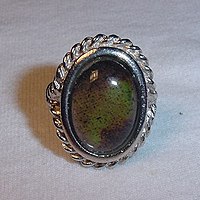Mood ring


A mood ring is a novelty ring which changes color in response to body temperature, using a thermochromic liquid crystal. A form of biofeedback, they supposedly indicated the temperment of the wearer, indicated by the ring's color. Mood rings were a fad whose popularity peaked in the United States in the 1970s, and they are now seen as an icon of 1970s culture.
There are many different types of mood ring, and it generally depends on the manufacturer what the "meanings" of the colors are, although, the most common ones are listed below. They come in necklaces, earrings, toerings, and finger rings. Generally speaking, the finger rings and the earrings are the most popular.
History
The Mood Ring was invented by Marvin Wernick. He is featured in a book called "Why Didn't I Think of That?" by Robert Shook. The Shook book covered 10 multi-million dollar ideas and their inventors. Some of the other fun fads covered in the book are The Slinky, The Hula Hoop and Celestial Seasonings.
The Mood Ring was invented in the late 60's when Wernick accompanied a doctor friend of his to an emergency nearby. When the doctor pulled out a strip of thermotropic material to gauge the child's temperature by applying the strip directly to his forehead, jewelry designer Wernick knew he had the makings of a winning item. (The child was fine, by the way.)
Wernick encapsulated ovals of the material within clear glass cameos and glass domes set in brushed gold and silver ring settings. His signature "hang-tag" explained the ring's amazing properties. (Pictures to the right are not original Mood Rings, but independent manufacturers using the concept.)
While some attribute the invention of The Mood Ring to Joshua Reynolds, even Reynolds won't take credit for it, as he's aware that he, in fact, was one of the many to jump on the Mood Ring craze, copying a winning (and unfortunately for Wernick, unpatented) item.
Joshua Reynolds, reportedly invented the Thighmaster, and was the heir to the Richard Joshua Reynolds tobacco fortune. Reynolds envisioned the mood rings as "portable biofeedback aids", and managed to sell $1 million worth of them in a three month period in 1975. Even so, Reynold's company went bankrupt, victim of a flooded market of imitations.
Workings of a Mood Ring
The "stone" in a mood ring is essentially thermotropic crystals covered or surrounded by glass. These crystals are very sensitive. When their temperature changes, their components change, or "twist". Light that hits upon the crystals will have different wavelengths absorbed and reflected. For more information on the perception of colors, see Color. The heat from your finger is conducted to the inside of the ring, and "twists" the crystals inside. The crystals then reflect different wavelengths of light, thereby changing the color of the ring.
The meanings of various colors
Due to fluctuations in the making of mood rings by various companies, interpretation of mood ring colors are not universal. However, a certain standard is fairly prevalent, and is the only one commonly found in any form of documentation. This standard is based on the crystals being calibrated to have the color green reflected at 82 degrees Fahrenheit (28 degrees Celsius), which is the typical surface temperature of people. Variations of the actual "neutral temperature", caused by differing surface temperatures among different people, as well as effects from outside temperatures, cause mood ring measurements to differ, and make their readouts rather unreliable.
- Black: Tense, nervous, harassed, overworked, beaten
- Gray: Anxious, nervous, strained
- Amber: Nervous, emotions mixed, unsettled
- Green: Average reading. Active, not under great stress
- Blue-green: Emotionally charged, somewhat relaxed
- Blue: Relaxed, at ease, calm
- Dark blue: happy, romantic, passion
When people undergo stress, their surface body temperature drops. This is represented in the mood ring's color phasing from the neutral green to amber, to Grey, to black. Conversely, a passionate mood causes one's capillaries to move closer to the surface, raising surface temperature. This is rendered in the mood ring by the color moving toward blue-green, blue, and then a darkened blue.
In Pop Culture
- A mood ring plays a key part in the 1991 movie My Girl.
- "Mood Rings" is a song by Relient K, about emotional girls and their unpredictability.
- R&B singer Mýa named her third CD Moodring because she felt that each song represented a different color.
- Skate-Gate, an episode of The Replacements, reveals that Dick Daring, Riley and Todd's father, wears a mood ring.
External links
- Super70s.com Contains more information about the mood ring and other 1970s fads.
- How stuff works
- Happyrings.com
- MoodJewelry.com Contains a mood ring color chart of 7 more unusual colors with their mood meanings in addition to the 7 standard colors commonly used on mood ring charts.
- MoodColors.Com A very unique mood ring color chart with some variation to the common color names and emotions used to describe the mood you're in.
- A Mood Ring An online virtual mood ring.
